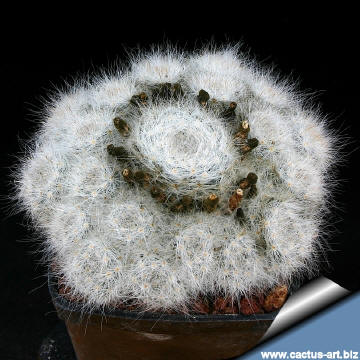 |
Description: It is a small
plant that forms low clusters. Individual stems
are globose.
Stems: Globular 40-50 mm in diameter, becoming
cylindrical, to 10 cm high. Without latex
Tubercle: Cylindrical
Axil: With short white indumentums and usually 3-8 hairlike
bristles 3-15 mm long.
Central spines: 1 longer erect, straight or hooked, 5-7 mm long,
white, brown on the tip, and 4 to 7 straight, 4-6 mm long, more or less
orderly, dispersing to the sides, while difficult to distinguish from
radials.
Radial spines: 50-75, 4-14 mm long, , interlacing, hairlike,
white.
Flowers: Often not opening completely, white, with a pink nuance,
usually 16-18 X 18-22 mm
Fruit: 15-17 X 3-5 mm, greenish- white to pale pinkish-olive.
Ripens about 3 months after flowering
Seeds: Pear-shaped, 1.2 X 1.0 mm, black.
Vaguely resembles Mammillaria prolifera; Glass and Foster consider it
simply a variety of Mammillaria glassii. |
|
Cultivation: Of easy culture and recommended for
any collection,
it doesn't requires any special treatment.
It readily forms clumps of many small
heads. It needs as much light as possible without burning the plant, to
encourage the heaviest spine formation.
Growth and flowering are
improved under these conditions. Use very gritty potting mix (rot prone)
For best results, use a shallow pot, and only use the smallest
diameter pot that will accommodate the plant. Regular water in summer,
dry in winter. The use of a covering gravel is a good way to preserve
the whiteness of spines. Frost tolerance -6° C.
Reproduction:
Seeds or offsets.
Photo of conspecific taxa, varieties, forms and
cultivars of Mammillaria glassi:
|